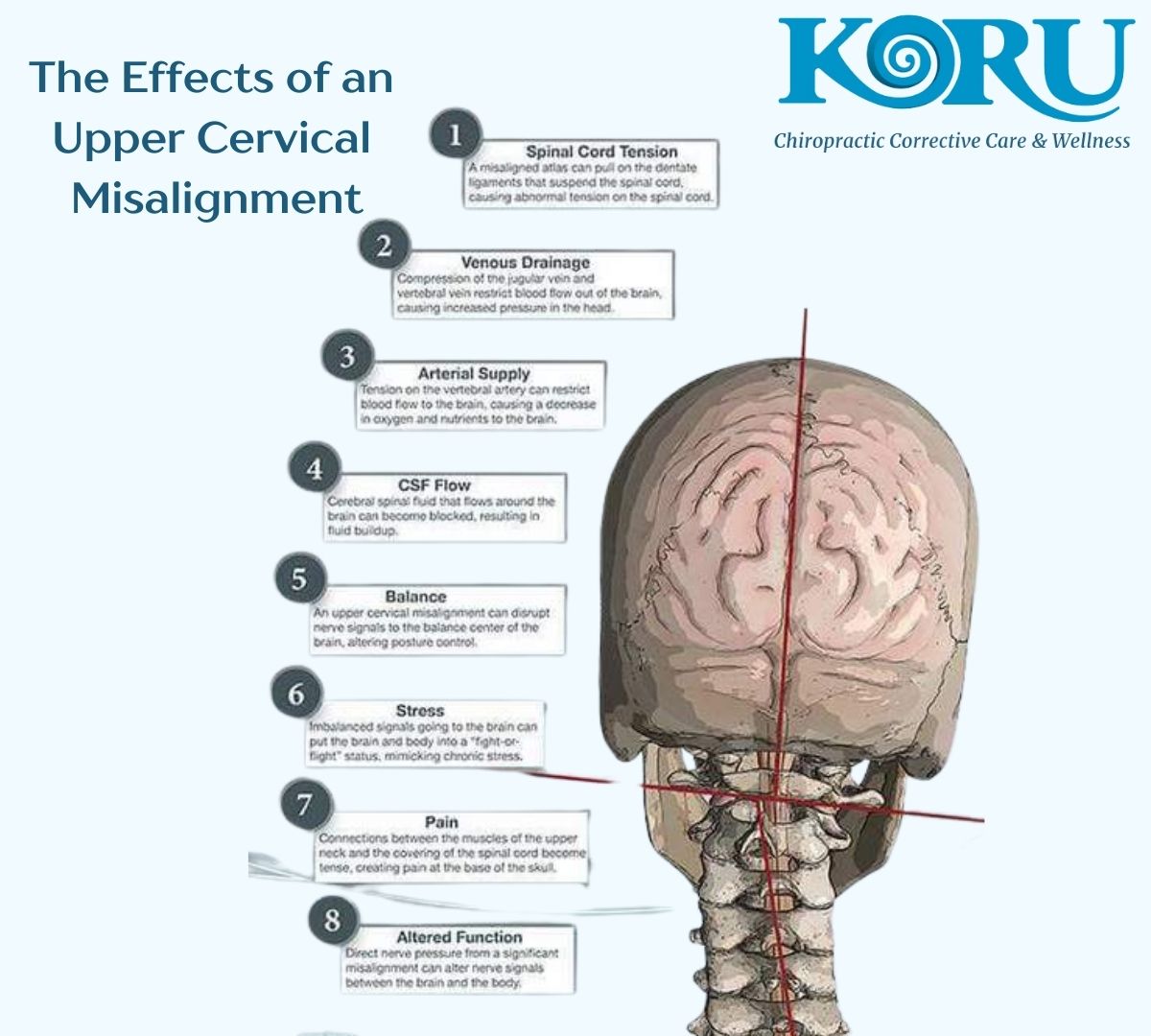Table of Contents
ToggleWhen it comes to health, we may not often consider the alignment of the uppermost vertebra, known as the atlas. Yet, as Dr. Norris Golberg, Clinical Director of Koru Chiropractic, located in Louisville, Colorado and serving Boulder County and the Great Denver Metro area, notes, the atlas plays a central role in maintaining proper neurological function and overall health. One important concept in chiropractic care, as highlighted in Dr. Eriksen’s authoritative work Atlas Subluxation Complex, is that misalignment of the atlas can disrupt vital physiological functions, leading to a host of health issues. In this blog, we’ll explore what the Atlas Subluxation Complex (ASC) is, its potential causes, and the ways in which it impacts the body.
What is the Atlas Subluxation Complex?
The atlas vertebra, or C1, is located at the top of the spine, supporting the skull and facilitating a wide range of head movements. This vertebra also serves as a protective layer for the brainstem, which is essential for relaying signals between the brain and the body. According to Dr. Eriksen’s textbook, the atlas is unique because it doesn’t interlock with an intervertebral disc, like other vertebrae, making it more vulnerable to shifts or misalignments (Atlas Subluxation Complex, Eriksen, 2004). It’s also the most mobile vertebrae, with the biggest ranges of motion, with rotation in particular, making it again more vulnerable to misalignment.
When the atlas shifts out of its natural alignment, it can exert abnormal pressure on nerves, blood vessels, and even cerebrospinal fluid flow, leading to a condition known as Atlas Subluxation Complex (ASC). This specific misalignment disrupts neurological communication, often triggering widespread physiological responses and symptoms.
Causes of Atlas Subluxation Complex
Several factors can lead to ASC. As Dr. Eriksen highlights, the atlas’s unique anatomical position makes it susceptible to misalignment from both internal and external forces (Atlas Subluxation Complex, Eriksen, 2004):
- Physical Trauma: Accidents, falls, or sports-related injuries can lead to whiplash or impact injuries, which often disturb the alignment of the atlas vertebra.
- Postural Stress: The repetitive strain from poor posture or extended screen time, often overlooked, can gradually affect the alignment of the upper spine.
- Birth Trauma: In infants, the atlas can become misaligned during birth, which may go undetected and uncorrected throughout childhood, as noted in Dr. Eriksen’s research.
How Atlas Subluxation Complex Affects the Body
Due to its connection with the brainstem, ASC can disrupt the natural flow of nerve impulses, and blood supply to the brain and brainstem, as well as alterations in Cerebral Spinal Fluid Flow (CSF) impacting various systems and causing symptoms that may seem unrelated on the surface.
- Chronic Pain and Headaches: Dr. Eriksen’s textbook details how ASC can often be traced back to cases of chronic head and neck pain, including migraines and tension headaches. Misalignment places undue pressure on the occipital nerves and surrounding tissues, causing persistent discomfort and restricted movement.
- Dizziness and Vertigo: The atlas vertebra is located close to the inner ear structures, which are essential for balance. As Eriksen notes, misalignment can lead to symptoms like dizziness and vertigo, particularly due to pressure on the cranial nerves involved in spatial orientation.
- Nervous System Dysfunction: By affecting the brainstem, ASC can significantly disrupt normal neurological functions. According to Dr. Eriksen, the misalignment impedes nerve signal transmission, which can lead to fatigue, memory issues, difficulty focusing, and even changes in mood due to altered neurotransmitter flow.
- Immune System Suppression: A compromised nervous system can also negatively impact immune function. Dr. Eriksen highlights the connection between ASC and immune suppression, as the brainstem’s communication with various organs becomes hindered, making the body more susceptible to illness.
- Postural Imbalance and Musculoskeletal Pain: Misalignment in the atlas affects the entire spinal column, as noted in Atlas Subluxation Complex. When the atlas is out of place, compensatory adjustments occur in the lower back, hips, and shoulders, often leading to chronic postural issues and musculoskeletal pain.

The Role of Chiropractic Care in Correcting ASC
At Koru Chiropractic, Dr. Norris Golberg employs an advanced technique known as NUCCA, to correct atlas misalignments. Drawing from research in the Atlas Subluxation Complex, Dr. Golberg uses precision-based, gentle adjustments to restore the atlas to its optimal position. By addressing ASC, chiropractic care aims to resolve symptoms at their source, improve nerve communication, Blood flow, and cerebral spinal fluid flow, and promote the body’s innate healing abilities.
Conclusion
Atlas Subluxation Complex may seem like a minor structural misalignment, but its impact on health can be profound. If you’re dealing with unexplained symptoms such as chronic pain, dizziness, or immune system issues, it may be worthwhile to consult a chiropractor with expertise in atlas corrections. At Koru Chiropractic, Dr. Norris Golberg and the team are dedicated to addressing the root causes of health challenges, using a personalized and comprehensive approach.
For more information or to schedule a consultation, contact Koru Chiropractic today. Discover the benefits of realigning your health from the top down!
References:
- Eriksen, K. (2004). Atlas Subluxation Complex. Chiropractic Biophysics

 Reviews
Reviews